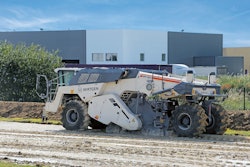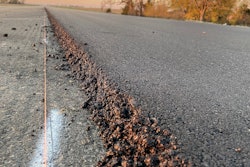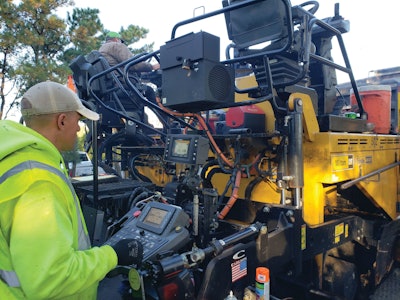
The specter of robotics casts as large a shadow as it ever has. It's a concept that dates as far back as the early futurist visions of 1960s America, and, even in earlier in fiction. The idea of articulated, intelligent machines doing the work previously exclusive to manual, human labor--it's nothing new. However, many significant advances have been made in the realm of artificial intelligence, as well as other strides in general computational power and robotics in the last decade. These technological leaps suggest that the automated future may be poised to make the transition from fiction and frequent political talking point, to a broadly tangible reality.
“The Future is Already Here, it's Just Not Very Evenly Distributed.”
-William Gibson, American author
The Future is Already Here
The first question that immediately comes to people's minds, when the subject of automation come up, is: When? But that could be interpreted as the wrong question to ask at this point in history, because the very real answer to it is: Now. Or even: Yesterday. So much of our lives, daily interactions, and facets of many industries are already heavily automated.
Automation takes so many different forms, though, so it is able to often go unnoticed when something that used to be done by a living, breathing person is sublimated by either an intelligent algorithm, a mechanical process, or something else on that spectrum. Other times, the level of automation around us is camouflaged by a human worker visibly participating alongside a robot on an assembly line, or even in a fast-food kitchen. What's harder to see is the invisible ways that a single laborer's efforts are now exponentially more efficient due to the effects of discreetly automated systems around them. With their assistance, one person can now do the work of several.
An often cited piece of evidence when discussing the stagnation of wages for "unskilled" labor versus the skyrocketing levels of efficiency and productivity. According to the Economic Policy Institute (EPI) "Productivity measures how much total economy wide income is generated (i.e., for workers, business owners, landlords, and everybody else together) in an average hour of work. As productivity grows and each hour of work generates more and more income over time, it creates the potential for improving living standards across the board." However, since the 1970s certain policy decisions and trends in the U.S. delinked wages and productivity. This includes but is not limited to, anti-union activities by employers being tolerated, decreases in tax rates for the richest Americans, the unraveling of anti-trust laws, and the deregulation of the trucking and airline sectors. What this amounts to is this: From the end of the 1970s to 2020, net worker productivity rose a staggering 61.8% while the hourly wages for workers only increased by 17.5%, adjusted for inflation.In an article about the impact of automation by Harry J. Holzer (Senior fellow of economics studies at Georgetown University), published by the Brookings Institution in January 2022, the author tries to offer a balanced perspective, "On one hand, automation often creates as many jobs as it destroys over time. Workers who can work with machines are more productive than those without them; this reduces both the costs and prices of goods and services...On the other hand, there are workers who lose out, particularly those directly displaced by the machines and those who must now compete with them."
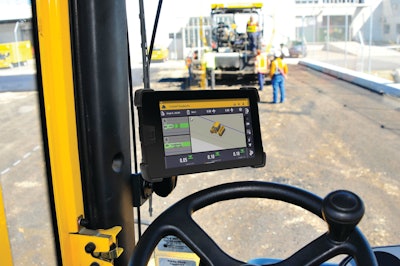 Provided by Trimble Industries
Provided by Trimble Industries
Previous sectors of the economy have already gone through earlier waves of automation, experiencing both situations described by Holzer. Some tasks were eliminated, but others were created to work alongside the machines. When considering how this might play out in the pavement and road maintenance industry, though a similar pattern might eventually emerge, for now it appears that the majority role automation will play is in partnering and enhancing the work that laborers are currently doing almost entirely manually.
This cooperative form of automation, and the accompanying labor paradigm really forces the conversation into a point of delineation. What do we mean by autonomy? What does it look like now? What will it look like in the near future? What will it mean for the job site of tomorrow?
Not Evenly Distributed
Devin Laubhan is the Paving Product Manager at Trimble industries, who's technology and products are directly involved with the development and deployment of autonomous solutions for construction companies. When asked about the current state of automation in the industry, he replied, "I like to use the term semi-autonomous. In my mind, the word 'autonomy' specifically relates to removing a person from the cab or the operator platform of a machine, and it then solely functions based on commands inputs into that machine. In the world of paving we have been somewhat semi-autonomous for years now."
But what about "full" autonomy? Is that on the table any time soon? Laubhan said, "So obviously yes, we are we are working on certain solutions, that are fully autonomous machines and where we where we started to dabble in that is specifically with a soil compaction machine." In other fields, they already have options available, "Since 2013, we've had a solution for our concrete pavers to be able to steer and control their elevation according to 3D designs created with a software called Trimble Business Center. These are executed without operator intervention, though a human is still responsible for moving it forward and stopping, that's a part of the process we don't control automatically."
The evidence is clear that the autonomous "revolution" isn't on the way, its here, in fact, it's been here for some time already. The distinguishing factor about it, however, is its pace and distribution. Rather than an explosive revolution, where an entire industry is flipped upside down all at once, like when digital downloads and torrenting caused a rapid change in the music and entertainment world; this transformation is much more gradual.
 Provided by Trimble Industries
Provided by Trimble Industries
Our robot overlord's takeover has rolled out piecemeal, in a segregated development. As each phase unfolds, a paradigm shift in one sector of the workforce acts as a leapfrog for the next. The general feelings amongst experts is fairly clear. Everyone is sitting on a ticking clock. So, the question then becomes: where is the paving and road maintenance industry in this revolution?
Laubhan offered this, as way of explanation, "When it comes to a dirt site, generally, it can be very easily contained. We can set up avoidance zones or boundaries where we say these machines must not go out of them. The one thing that really separates the paving world from earthmoving is we are generally working in areas of live traffic, and there's a lot of people around. When we're up against buildings and homes and traffic, there's a safety element that we have to really focus on before we can adapt autonomous solutions to asphalt equipment specifically."
For the time being, at least for Trimble, asphalt paving isn't on the table, but it is likely only a matter of time. "There's quite a bit that that has the potential for growth in the paving world," according to Laubhan, however, Trimble's focus is on the numbers. "The goal of autonomy is to increase the efficiency of any job site, whether it'd be an earthmoving or a construction site. Completing projects quicker, on budget, on time, and allowing a contractor to move on to the next project. We want them to have more control and understanding of their operations, to see where they can improve and where they may be lacking."
Development vs. Adoption Threshold
The creation of a new or future generation of automated road building or road maintenance machines is only one aspect of their eventual rise. As has been written about here already, the technology for this reality already exists, but putting it all together into a platform, like say a street-sweeper for example, and selling it on the market is an entirely different situation. The market is already in the middle of a major change, towards electrification, and that alone, in some ways, makes the question of autonomy both closer at hand (since newer vehicles are arriving much smarter than previous generations), as well as, seemingly still a question mark.
When asked about the future of development and autonomy, Tim Letts, product manager for the Elgin Sweeper Company, said about this scenario, "Right now we've been focusing our efforts and our resources on other more immediate needs, like electrification, because in our minds, that's more of a pressing customer need and want than the autonomy." However, it still is in the overall development pipeline. "It is something the industry is going to. [We are] definitely on the road to autonomy, and we'll get there because our products kind of lead into that, even if it is baby step towards it."
But as billions of federal dollars pour into the economy to quicken the pace of electrification of industrial fleets, might that impact those customer wants and needs?
 Provided by Trimble Industries
Provided by Trimble Industries
Letts continued, "They're not exactly in parallel development. But they're kind of going along together hand in hand there. The amount that you can control with an electric vehicle to begin with, it's vastly superior compared to a diesel truck. Once it becomes a standard, you know, it's interesting, because, in my mind, for an autonomous vehicle to be the standard..." Letts paused, seemingly considering unspoken factors, "I don't know if that might ever be the standard in our lifetime, to be quite honest."
But there are options for "early adopters" that could divert some of the burden of such a capital investment. Trimble's Laubhan explains there could be alternatives, "We don't necessarily need brand new machines, older machines can definitely be retrofitted with autonomous technologies." But this option has its own limitations too Laubhan says, "It comes down to indication systems versus automatic systems. On older machines, we can we can install what we call indication systems where we tell the operator, 'Here's where you need to guide your excavator bucket to be to dig out this trench at this slope', but we don't we don't actually perform any of the automatics for the operator."
However, retrofitting newer machines, made within the last eight years, yields greater improvements. "They come from the factory a lot smarter than they used to be. They have integrations for our external machine control systems. They have electronic control modules connected to the cloud," Laubhan said. "We're able to provide a little bit more for those. The operator just has to sit in the cab and pull the stick and the excavator bucket will actually follow a design slope that is built into it. So, the operator doesn't need to control three independent movements of the boom they just need to control one: pull it back and push it forward."
The threshold for adopting autonomous vehicles has other hurdles too, not just related to costs. Letts pointed out, "When you throw in another level of software [like artificial intelligence], it's going to be another hurdle, and regulations might have to come before we can really gain some traction."
According to the Insurance Institute for Highway Safety (IIHS) only a single state has yet to make autonomous vehicles (AV) legally deployable (Oklahoma) though there are varying degrees of licensure, certification and insurance requirements that can range from $2 million to $5 million in liability coverage. Twelve states are only open to AV testing, and three states only permit commercial use vehicles. To Tim Lett's point, there is a lot of grey area out there in the world of AVs, and a lot of ground work legislation still needs to be hammered out before the market can really know what will be most viable.
End of Line
Sometimes it can feel like our modern world is full of technological marvels, and then we take a look around and wonder where the jet-packs and the flying cars are? While some thing have taken huge leaps forward, like communication technologies, others haven't taken as big of steps forward as was expected by popular thought. But where do those expectations come from? Often times they enter the social and collective consciousness through media, entertainment, and science fiction.
As a way of extrapolating from those shared notions about the future, the question still remains about the timeline to a future of fully robotic machines. Fifty years? One-hundred years? Trimble's team wouldn't answer specifically, but would speak to the idea itself.
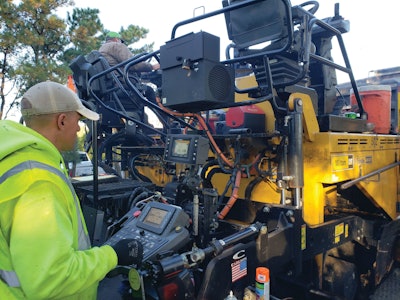 Trimble Industries
Trimble Industries
"I do think that is where the industry is trying to get. Now, how long it takes us to get there, that's that's another question. But I do see that fully autonomous machines will definitely be a part of our future," Laubhan said. "I do think that there are there are quite a few technological leaps that need to happen. I think that those innovations are happening quite frequently nowadays. There are so many talented, intelligent people who are who are working on it, so I do feel that it is achievable."
For now, what appears to be a consensus among experts is: no matter how many tasks machines are able to take over responsibility for, the human element cannot be fully eliminated. It is much more likely that the human element will be shifted around, taking on different types of tasks, wether as operators, maintenance, or support staff. The resulting world will look different, just like it already does compared to the 1980's or 1990's. Our smart devices are integrated into the fabric of our lives, even our ways of thinking. It is possible to see a future where the prevalence of artificial intelligence and automated machines because so commonplace, that we barely notice it at all.





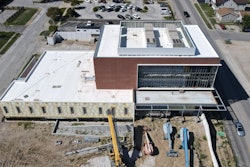
![2023 Top 30 Asphalt Contractor Logo[78]](https://img.forconstructionpros.com/files/base/acbm/fcp/image/2022/12/2023_Top_30_Asphalt_Contractor_Logo_78_.638a68aa251f2.png?auto=format%2Ccompress&fit=crop&h=167&q=70&rect=69%2C0%2C1779%2C1002&w=250)
